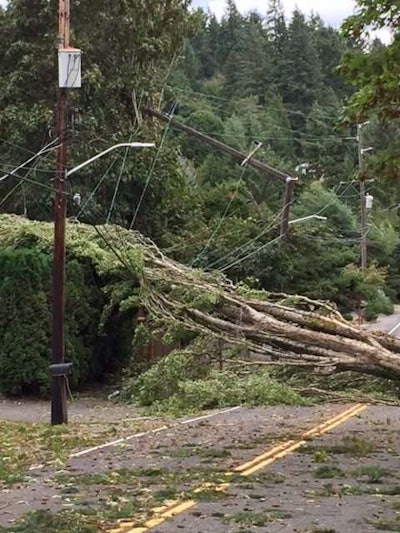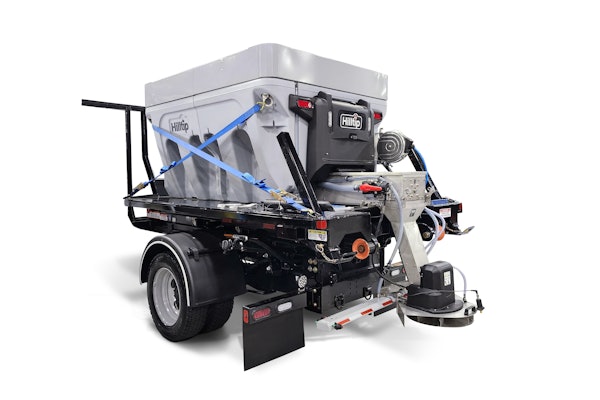 Photo: Comcast Washington State/Flickr
Photo: Comcast Washington State/FlickrStorms, both expected and unexpected, can be some of the most damaging natural occurrences in the landscape industry. Storms can appear out of nowhere in an instant, and just as quickly dissipate with little to no warning. While it’s true we can never be completely prepared to handle all types of natural disasters, taking a few precautions ahead of time when designing your customer’s landscape can help in the long run when these storms do show up.
Storm-resistant landscape
When it comes to storms arriving, one of the main issues is with trees. Trees can not only cause excessive damage to homes and landscapes, they can also endanger the lives of your customers. However, planting wind-resistant trees with stronger, deeper root systems, such as the magnolia, bald Cyprus, winged elm and live oak, will help keep your customer’s lawn beautiful and storm-ready. These trees also have the ability to easily shed their leaves to prevent a sail-like effect that can blow them over.
On the other end of the spectrum, avoid planting trees that have weaker trunks and are fast-growing, as well as those that are dense with top-heavy canopies, such as the willow, box elder, cottonwood, and red cedar. These types of trees are more prone to snapping or uprooting.
Storm-proofing trees and plant preparation
After you’ve completed a project for your customer, it’s only natural to have follow-up appointments with them to make sure everything is running smoothly. While making these visits, be sure to check on all of the trees you’ve planted to watch for any potential hazards or warning signs that they may be unstable.
Be sure to remind your customers to keep a vigilant eye out as well, since you cannot be there all day, every day to watch. Remind them to check their trees periodically for any that seem to be dying, rotting, or that have sustained any damage. This is especially important to do after a storm has hit to ensure further damage to the home and landscape does not occur. If you or your customers do find any damaged or dying trees, remove them quickly and safely. For garden beds that are exposed and unable to be moved, offer protection by surrounding them with either large bags of garden soil or sandbags.
Remove garden hazards
As we said earlier, we know that you can’t always be on alert for storms, but taking a few precautionary steps is always beneficial in the long run. When it comes to items such as benches, planters, and other fixtures in your customer’s landscape, consider finding a way to secure them to the ground in case of hard winds, or recommend they be moved indoors.
If you and your customers know a storm is brewing, tell them to bring any hanging baskets, potted plants, garden ornaments, or decorations indoors as a first step. If they have some potted plants that are too large for them to bring inside, tell them to bunch them together in a cluster to help better protect them. Larger potted trees can be laid on their sides in a sheltered location and tied down.
Proper drainage
Proper drainage is important in a landscape whether you want your customers prepared for a storm or not, but it can certainly come in handy when the downpours arrive. When designing the landscape, be sure to avoid any built-up garden beds or other landscape features that could potentially direct rainwater or runoff toward the foundation of the house.
If you are newly hired to a project and are following behind the work of another landscaper, be sure to thoroughly inspect the work that was already done. There may be a very good reason why you were called to replace the former landscaper.
If you see that the home does not have proper drainage options, talk to the customer about having a French drain installed. These draw groundwater and pooling surface water away from the home, and they can help redirect water that pools in the middle of the yard. Adding soil and raised beds can also help eliminate sunken areas and prevent extra water from collecting.
Avoiding erosion
Plants help prevent these heavy rains from washing away the soil in landscapes, and their root systems act like a mesh that holds the dirt together. When the threat of severe weather is less eminent, as it is in the winter months, consider uprooting dead shrubs.
During the wet-weather seasons, it’s also recommended that you try not to seed or replant hilly areas and slopes. Talk to your customers about installing rock gardens along those areas to help catch water and prevent erosion on the inclines. Planting fast-growing ground cover plants around trees and in areas around the landscape where grass has yet to take root can also help reduce the risk of erosion.
Storms can be sneaky or they can announce themselves days in advance; either way, having these preparedness tips in your back pocket could help save your customer’s yard, home, and life.












